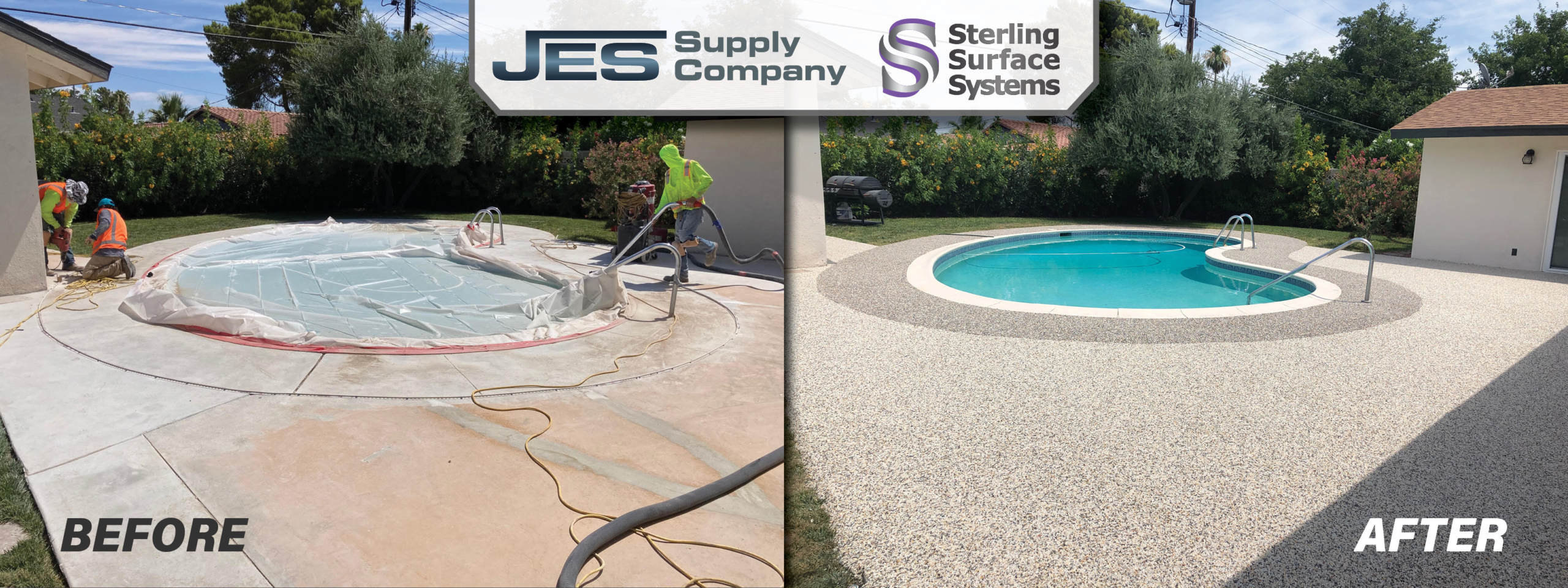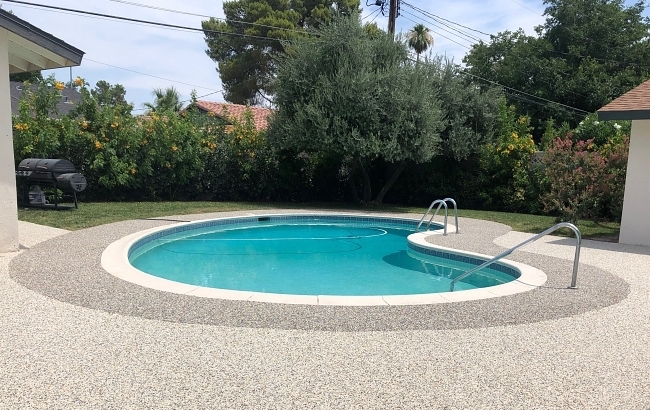Polyaspartic vs. Epoxy

In the world of pebble overlays, the majority of installations consist of pebbles mixed with epoxies. We have found a superior product to replace epoxies for this application. Aliphatic Polyaspartic! We put forth 5 reasons why Polyaspartic is a superior material when compared to epoxies for this type of application.
- Flexibility: Epoxies cure to become a brittle surface causing issues with flexibility. In an outdoor environment, there is constant movement in the concrete due to daily and seasonal temperature change. As the concrete heats, it expands, and as it cools, it contracts causing that constant movement. No two materials expand and contract at the same rate due to their densities. This constant movement causes the epoxies and concrete to work against each other, which will eventually cause the bond between the two to fail, all due to the brittleness of the epoxies. Polyaspartic cures to a strong, yet flexible surface with fantastic bonding capabilities. Our Polyaspartic JES Seal has an elongation of up to 70%, which is far superior to epoxies. Polyaspartics are used to protect structures and surfaces that have movement designed into them or are exposed to extreme conditions, such as offshore drilling rigs.
- Hardness: Epoxies when cured become very hard. In some applications this is a good thing, but not in the world of pebble overlays. Drop something heavy on a hard epoxy surface, and you may have a nice chip, gouge, or even crushed pebbles, making an unsightly mess in the middle of your feature floor coating. Polyaspartics cure to a hardness of 70 Shore D, which is not as hard as many epoxies, but hard enough to support all vehicle traffic. Because it is not hard, it will absorb the sudden impact of a dropped hard/heavy object, thereby minimizing possible damages.
- Volatile Organic Compounds (VOC): There are very few epoxy resins that contain zero VOCs. Those that do are more expensive. Most will advertise themselves as having “low VOCs.” VOCs are harmful to inhale and can cause negative respiratory conditions, not only at the time of installation, but throughout the life of the material. Our Polyaspartic is free of all VOCs, no need to worry about your health.
- Ultraviolet Radiation (UV): UV is one of the Achilles Heels of epoxies. The UV light from the sun will begin breaking down the epoxy molecules as soon as it cures. The beginning of this process is witnessed by the yellowing of the epoxy coating. Many coating companies will use epoxies treated with UV inhibitors to “glue” the pebbles to the surface and then use a Polyaspartic to seal the epoxies from the UV to help slow the UV from reaching the epoxy. This helps to some degree, but it will never stop the sun from penetrating to the epoxy. It will yellow! To combat this companies will offer maintenance contracts to “reseal” the newly installed surface. Polyaspartics will not yellow. Again, that is why many companies will seal over their epoxies with a Polyaspartic because it will at least delay the inevitable.
- Return to service: Epoxies take longer to cure than Polyaspartics. Why is this an issue? The longer it takes to cure, the more airborne materials will be deposited and trapped on the surface as it is curing, such as dust, small leaves, insects, and other airborne elements. Polyaspartics have a much quicker curing time. One of the main reasons that installers do not use Polyaspartics to bond their pebbles is they will have to work more quickly which can be challenging when placing the material.
You might ask yourself, why are the other installers not using Polyaspartics? There are several reasons, a few might be the shorter working time of the Polyaspartic, the cheaper cost of epoxies, and resistance to change. Epoxies have been around since 1934, old technology. On the other hand, Polyaspartics were invented in 1977, newer technology.

JES Seal, our Polyaspartic, is superior to epoxies for this and other types of applications. It is 100% solids, meaning it will not shrink when cured. Its tensile strength is as high as 3,200 psi, meaning, if you attempt to pull the JES Seal off the concrete the JES Seal would pull the concrete up with it. It has high abrasion resistance, is USDA approved for incidental food contact, has a superior high gloss finish for that WOW factor, and can be customized with color. Additionally, anti-fungal and biocides can be added to help kill viruses, molds, fungi, and other harmful contaminants.

